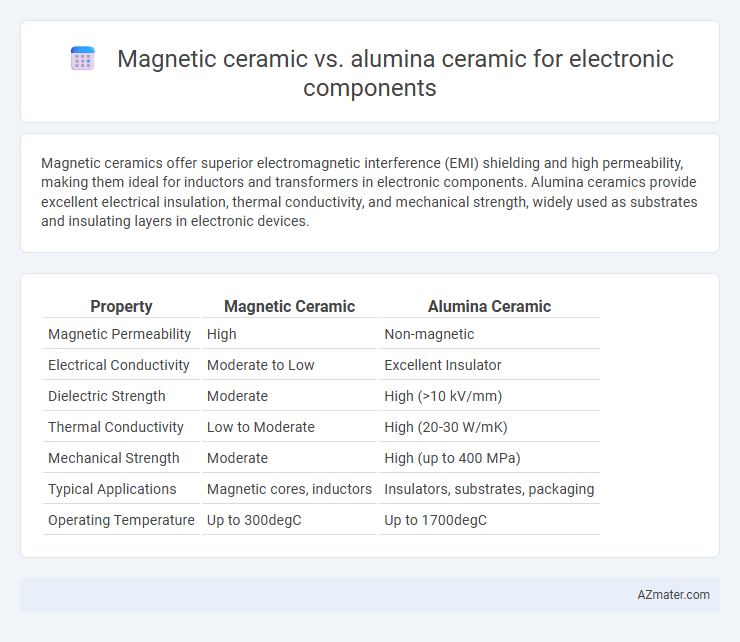Magnetic ceramics offer superior electromagnetic interference (EMI) shielding and high permeability, making them ideal for inductors and transformers in electronic components. Alumina ceramics provide excellent electrical insulation, thermal conductivity, and mechanical strength, widely used as substrates and insulating layers in electronic devices.
Table of Comparison
| Property | Magnetic Ceramic | Alumina Ceramic |
|---|---|---|
| Magnetic Permeability | High | Non-magnetic |
| Electrical Conductivity | Moderate to Low | Excellent Insulator |
| Dielectric Strength | Moderate | High (>10 kV/mm) |
| Thermal Conductivity | Low to Moderate | High (20-30 W/mK) |
| Mechanical Strength | Moderate | High (up to 400 MPa) |
| Typical Applications | Magnetic cores, inductors | Insulators, substrates, packaging |
| Operating Temperature | Up to 300degC | Up to 1700degC |
Introduction to Magnetic Ceramics and Alumina Ceramics
Magnetic ceramics, typically composed of ferrite materials such as manganese-zinc (MnZn) or nickel-zinc (NiZn) ferrites, exhibit high magnetic permeability and low electrical conductivity, making them ideal for inductors, transformers, and magnetic cores in electronic components. Alumina ceramics (Al2O3) are known for their excellent electrical insulation, high thermal conductivity, mechanical strength, and chemical stability, frequently used as substrates and insulating components in electronic devices. The choice between magnetic ceramics and alumina ceramics depends on the specific application requirements, balancing electromagnetic properties and thermal or mechanical constraints in electronic component design.
Material Composition and Structure Comparison
Magnetic ceramics typically consist of ferrites such as manganese-zinc (MnZn) or nickel-zinc (NiZn) compounds with a spinel or garnet crystal structure, providing high magnetic permeability and low electrical conductivity, essential for inductors and transformers in electronic components. Alumina ceramic (Al2O3) features a dense, crystalline structure with excellent electrical insulation, high mechanical strength, and thermal stability, making it ideal for substrates, insulators, and heat sinks in electronics. The compositional difference lies in magnetic metal oxides for magnetic ceramics versus pure aluminum oxide in alumina, which defines their distinct electromagnetic and thermal properties.
Electrical Properties: Conductivity and Insulation
Magnetic ceramics exhibit moderate electrical conductivity due to their ferrite composition, making them suitable for applications requiring controlled magnetic permeability and low eddy current losses. Alumina ceramic, with its exceptional electrical insulation and high dielectric strength, is widely used in electronic components demanding excellent insulating properties and resistance to high voltages. The choice between magnetic ceramics and alumina ceramics depends on the specific need for magnetic functionality versus superior electrical insulation in electronic applications.
Magnetic Properties: Suitability for Electronic Applications
Magnetic ceramics exhibit superior magnetic permeability and lower coercivity, making them ideal for inductors, transformers, and magnetic cores in electronic components requiring efficient magnetic response. Alumina ceramics, while possessing excellent electrical insulation and thermal stability, have negligible magnetic properties, limiting their use in applications where magnetic functionality is critical. The suitability of magnetic ceramics for electronic applications is primarily determined by their ability to enhance magnetic flux and reduce energy loss, unlike alumina ceramics which are preferred for insulating and substrate materials.
Mechanical Strength and Durability
Magnetic ceramics offer moderate mechanical strength and durability, suitable for applications requiring magnetic properties but may exhibit brittleness under high stress. Alumina ceramics excel in mechanical strength with high hardness and fracture toughness, providing superior durability in harsh environments. Their excellent wear resistance and thermal stability make alumina the preferred choice for electronic components demanding long-term reliability and mechanical resilience.
Thermal Stability and Heat Resistance
Magnetic ceramics exhibit moderate thermal stability and heat resistance, typically withstanding temperatures up to 600degC, making them suitable for applications requiring magnetic functionality with moderate thermal demands. Alumina ceramics, known for their superior thermal stability, can endure temperatures exceeding 1600degC, providing excellent heat resistance essential for high-temperature electronic components. The high melting point and low thermal conductivity of alumina ceramics ensure minimal thermal expansion and enhanced reliability in extreme heat environments compared to magnetic ceramics.
Cost and Manufacturing Considerations
Magnetic ceramics generally have higher raw material costs and require specialized manufacturing processes such as sintering under controlled atmospheres, leading to increased production expenses compared to alumina ceramics. Alumina ceramics benefit from widespread availability and well-established manufacturing techniques like pressureless sintering, making them more cost-effective for high-volume electronic components. Manufacturing alumina ceramics also offers better scalability and consistency, which reduces overall production time and cost variability in electronic component fabrication.
Typical Applications in Electronic Components
Magnetic ceramics, such as ferrites, are commonly used in inductors, transformers, and electromagnetic interference (EMI) suppression due to their high magnetic permeability and low electrical conductivity, enabling efficient magnetic field manipulation in electronic components. Alumina ceramics, notable for their excellent electrical insulation, thermal conductivity, and mechanical strength, are widely applied in substrates, insulators, and package bases for semiconductors and integrated circuits. The choice between magnetic ceramic and alumina ceramic depends on the application requirements for magnetic properties versus electrical insulation and thermal management in electronic component design.
Performance Under Harsh Operating Conditions
Magnetic ceramics exhibit superior electromagnetic properties and enhanced thermal stability, making them ideal for electronic components operating in high-frequency and high-temperature environments. Alumina ceramics offer excellent mechanical strength and exceptional resistance to thermal shock, ensuring reliability under extreme mechanical stresses and rapid temperature fluctuations. Both materials provide distinct advantages for harsh operating conditions, with magnetic ceramics excelling in electromagnetic performance and alumina ceramics delivering unmatched durability and insulation.
Choosing the Right Ceramic for Your Electronic Needs
Magnetic ceramics offer superior electromagnetic interference (EMI) shielding and high magnetic permeability, making them ideal for inductors, transformers, and microwave devices. Alumina ceramics provide excellent electrical insulation, high thermal conductivity, and mechanical strength, which suit substrates and insulators in electronic components. Selecting the right ceramic depends on your electronic application's requirements for magnetic properties versus thermal and electrical insulation, ensuring optimal device performance and reliability.

Infographic: Magnetic ceramic vs Alumina ceramic for Electronic component
 azmater.com
azmater.com